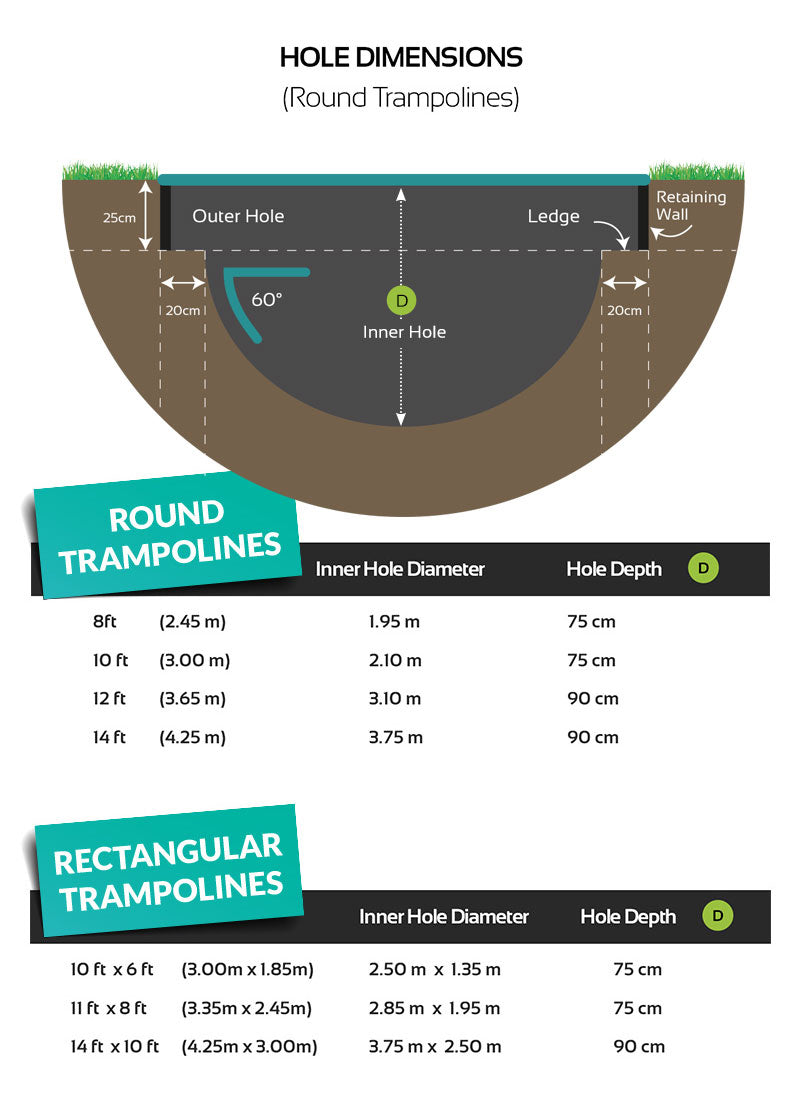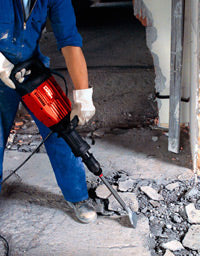How to dig a hole for an in-ground trampoline

Digging a suitable hole for an in-ground trampoline is the biggest concern for most people considering installing this type of trampoline. Whilst not an exact science, digging a hole is not as difficult or expensive as most people think. This post looks at the various options open to you and some best practice recommendations for the purpose-built Capital In-ground trampoline kits.
Mini-digger or hand dig?
If you're fit and healthy and enjoy a challenge then digging your own hole by hand has its advantages. It saves the mini-digger hire cost and all the arranging that goes with that. The headline cost of a mini-digger can be misleading, there are often additional extras such as delivery/collection and mileage charges. More importantly, unless you're trained in how to use a mini/micro digger then you need to find someone that is. Believe me, despite what a hire company may tell you, diggers are not that easy to use.
Of course, the big plus with a mini digger is the speed and ease with which a digger can excavate your hole. It will save a large amount of time and expensive visits to the physio to get your back sorted!
If you're still not decided as to whether you need a digger then also look at how difficult the soil is to dig out the ground. If you have soft soil, mainly topsoil, then digging into this is not nearly as tough digging into clay or compacted soil. Many back gardens, especially in towns, have large amounts of rubble under the surface which is hard to manually dig out. Also you can sometimes come across concrete slabs and similar objects which are back-breakers to get out by hand.
 Important to note however is that a digger can only dig out the guts of the hole and not do any of the fine tuning of the hole dimensions (see above diagram) so there will always be an element of hand-digging. Whether hand-digging or using a mechanical digger, also bear in mind, you will still have to remove the soil to skip or area in your garden where you're disposing of it. Finally, a cost-effective half-way house is to hire in a 'breaker' such as the one pictured here from HSS hire. It only costs £30 - £40 a day to hire and will greatly assist in breaking up compacted hard soil, as well as loosening hard-core areas.
Important to note however is that a digger can only dig out the guts of the hole and not do any of the fine tuning of the hole dimensions (see above diagram) so there will always be an element of hand-digging. Whether hand-digging or using a mechanical digger, also bear in mind, you will still have to remove the soil to skip or area in your garden where you're disposing of it. Finally, a cost-effective half-way house is to hire in a 'breaker' such as the one pictured here from HSS hire. It only costs £30 - £40 a day to hire and will greatly assist in breaking up compacted hard soil, as well as loosening hard-core areas.
The last thing to really consider is access issues (such as steps or a narrow alley-way) that may hinder a mini digger getting to the trampoline area and also the damage it may do to your lawn, especially if it's wet or the ground is soft.
In conclusion, I'm a big fan of just digging the hole by hand - it's hard work but very rewarding. It saves considerable cost and hassle.
Shaping the hole.
Firstly, mark out the hole circumference as accurately as possible and allow about an extra 3 inches (but no more) to give you sufficient space to drop the trampoline in. You then need to take off the turf and keep some to one side - this can then be used at the end of the job to re-turf around the edge of the trampoline.
Excavate the full diameter section to a depth of 33 cm (the frame is 30 cm high and padding an extra 3 cm). This will leave you with a perfectly flush-to-ground trampoline. If you want to create a small lip up to the trampoline then only dig down 30 cm.

The idea now is to create a ledge about one foot or 30 cm wide for the frame to sit on before excavating an inner hole in a bowl shape.
You will have some space around the outer edge of the trampoline which you fill in later with some of the excess soil. Try to keep the space around the edge to a minimum because (however hard you compact it) you may get some unevenness over time caused by the earth settling in this area.
Dig the hole to the required depth in the middle as indicated above and try and create a bowl shape for the inner hole.
Drainage and weed membrane.
If you suspect you have a high water table or are prone to a lot of lying water on the ground when it rains, it's best to dig a trial hole about 3ft deep to see if water collects there and stays there. If it does, then an in-ground trampoline may not be suitable for your garden, or at best you'll need some specialist drainage or even a pump system.
This however is not normally the case, but we do recommend as a precaution to put in a simple soak-away at the bottom of the pit. All you do is create a further small hole at the bottom, about 2ft diameter and 2ft deep and fill with hardcore, rubble, scalping or similar. First of all however, wrap all the hardcore in a membrane - this will stop the soak-away from silting up and allow excess water to flow into through the hardcore.

Finally, it's best to line the hole with a weed membrane as pictured here. This will stop weeds from growing underneath (yes, weeds do grow in the dark) which could in time grow through the springs and/or interfere with the jumping area. You can anchor the membrane under the bottom section of the frame or (as we've done here) with small paving slabs.
For more information on this topic and to answer any other queries you may have, why not take a look at our FAQ page



